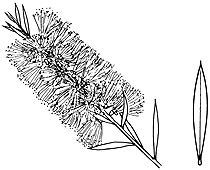Callistemon pungens Lumley & R.D.Spencer APNI* Synonyms: Melaleuca williamsii Craven APNI*
Melaleuca williamsii subsp. williamsii Craven APNI*

Description: Shrub or small tree 2–5 m high; branches rigid; new growth silvery.
Leaves oblanceolate to narrow-elliptic, 2–3 cm long, 3–5 mm wide, apex with pungent mucro 1–2 mm long, lateral veins usually not apparent, both surfaces with numerous small glands.
Spikes mostly 5–6 cm long, 35–45 mm diam. Filaments 12–14 mm long, purple; anthers purple.
Capsules 5–7 mm diam.
Flowering: summer.
Distribution and occurrence: Distribution extends from the Stanthorpe area in Queensland, south to Tamworth district and the Oxley Wild Rivers National Park. Grows in or near rocky watercourses, usually in sandy creek beds, wet heath or riparian woodlands on granite or trachyte substrates, less commonly on basalt.
NSW subdivisions: NT, NWS
Other Australian states: Qld
Threatened species: Commonwealth EPBC: Vulnerable
Three subspecies are recognised, 2 of which occur in N.S.W.
Text by R. D. Spencer & P. F. Lumley
Taxon concept: Flora of NSW 2 (1991)
| | Key to the subspecies | |
| 1 | Leaves with pronounced pungent point c. 2 mm long; stamens 1.2–1.5 cm long | subsp. pungens |
| Leaves with a pungent point c. 1 mm long or less; stamens 0.8–1.0 cm long | subsp. synoriensis |
APNI* Provides a link to the Australian Plant Name Index (hosted by the Australian National Botanic Gardens) for comprehensive bibliographic data
***The AVH map option provides a detailed interactive Australia wide distribution map drawn from collections held by all major Australian herbaria participating in the Australian Virtual Herbarium project.
|


